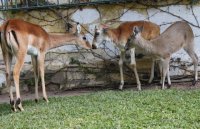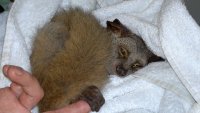|
You have to have a tough heart and a thick skin to stay in
this business. Our rehabilitation cases so far this year have
brought much angst, but also some hope in the sheer resilience
of wild animals and their uncompromising instinct to live.
Rehabilitation
At the end of February disaster struck for Sylvie the duiker
when she pronked off her bad leg and it broke through the
growth plate at the level of her metatarso-phalangeal joint. In
a bid to save the leg Keith performed a cross pinning operation
with an attempt to fuse the joint. In retrospect this was
probably too ambitious as the skin was already broken over the
joint. She developed an osteomyelitis which was resistant to
the oral antibiotics she was on. After ten weeks the fracture
site broke down necessitating amputation of the  limb. We were a little
worried to see if she would adapt as well as a dog of her
weight on three legs. If it’s one thing you do learn it’s that
animals don’t feel sorry for themselves and she was soon
pronking around again as if she had no disability at all. She
has gone back to Wild is Life to live out her days in comfort
with Cordelia the baby impala and Churchill the baby
wildebeest. Dudley the impala (treated in December 2011) fared
much better and he has made a full recovery from his fractured
foreleg (photos on our facebook page
http://www.facebook.com/pages/Aware-Trust-Zimbabwe/208441509209247). limb. We were a little
worried to see if she would adapt as well as a dog of her
weight on three legs. If it’s one thing you do learn it’s that
animals don’t feel sorry for themselves and she was soon
pronking around again as if she had no disability at all. She
has gone back to Wild is Life to live out her days in comfort
with Cordelia the baby impala and Churchill the baby
wildebeest. Dudley the impala (treated in December 2011) fared
much better and he has made a full recovery from his fractured
foreleg (photos on our facebook page
http://www.facebook.com/pages/Aware-Trust-Zimbabwe/208441509209247).
Owlie 2, a beautiful spotted eagle owl with a dislocated
wing also came in at the end of February. She was confined for
rest, initially with her wing strapped, although this didn’t
stop her dominating her caregivers with mock charges every time
her bedding was changed or food was brought to her. She’s a
fighter, and has made good progress. She has now been moved to
Bally Vaughan Animal Sanctuary where she is in the next stage
of her rehabilitation prior to release.
Perhaps our most interesting case was a sick cape pangolin
that was brought to Wild is Life due to the latter’s
unprecedented success with keeping cape pangolin in captivity.
This animal was allegedly caught by two men, and came to Wild
is Life through a welfare organization and the police at least
5 days after its initial capture, having not been fed in that
time. The animal was very ill and despite intensive veterinary
treatment by AWARE and round-the-clock care from Roxy at
 Wild is
Life, the pangolin succumbed. Post mortem examination revealed
a large tumour on the liver which has been confirmed by a well
respected histopathologist to be a hepatocellular carcinoma. Wild is
Life, the pangolin succumbed. Post mortem examination revealed
a large tumour on the liver which has been confirmed by a well
respected histopathologist to be a hepatocellular carcinoma.
 We
learnt a lot about the anatomy and physiology of this animal
(which not much is known about) during this case, including how
to sex them and where to take a blood sample from, and we
will be better equipped to deal with future pangolin
emergencies. This post mortem picture shows the animal’s
tongue, used for licking up ants in deep antholes, which
extends from his mouth then runs in a cartilage sheath and
attaches to the abdominal body wall at about the level of the
kidneys. We
learnt a lot about the anatomy and physiology of this animal
(which not much is known about) during this case, including how
to sex them and where to take a blood sample from, and we
will be better equipped to deal with future pangolin
emergencies. This post mortem picture shows the animal’s
tongue, used for licking up ants in deep antholes, which
extends from his mouth then runs in a cartilage sheath and
attaches to the abdominal body wall at about the level of the
kidneys.
Other cases with sad endings included euthanasing the ‘wild’
horse that we rescued last year, since the solid swelling on
her hock started to cause her extreme discomfort. On post
mortem examination this too was confirmed to be a tumour. Our
thanks go to Anton Newall for taking this horse in, taming her
down and giving her a decent quality of life for her last few
months.  An emaciated bushbaby found on the edge of town with
severe respiratory difficulty was also euthanased. On post
mortem examination we discovered an old scar which must have
been a bite from a cat or dog penetrating the chest. The
pleural cavity was full of foul smelling black fluid and the
lung tissue had been destroyed by infection. Sadly too, we have
recently diagnosed a large splenic tumour in Teddy, the icon of
lions on our website’s ‘Home’ page who has been living at Imire
Game Park for the last few years. He too is soon to be
euthanased. An emaciated bushbaby found on the edge of town with
severe respiratory difficulty was also euthanased. On post
mortem examination we discovered an old scar which must have
been a bite from a cat or dog penetrating the chest. The
pleural cavity was full of foul smelling black fluid and the
lung tissue had been destroyed by infection. Sadly too, we have
recently diagnosed a large splenic tumour in Teddy, the icon of
lions on our website’s ‘Home’ page who has been living at Imire
Game Park for the last few years. He too is soon to be
euthanased.
Our most recent rehabilitation case made the headlines in
our local paper, and is worth a read for its sheer
ludicrousness:
http://www.myzimbabwe.co.zw/news/1567-witchcraft-rumours-circulate-after-zebra-was-found-in-toilet.html.
The initial (pretty heroic) rescue was performed by Anton, who
rushed to the scene and darted the terrified zebras amongst a
sea of local residents who had somehow managed to get a noose
over the 8 month old stallion’s neck. Riot police had to beat
the crowd back from the truck carrying the immobilized
creature. The 2 zebra were taken to Lion and Cheetah Park game
farm  one at a time as an intermediate safe location. The
next morning a third zebra was desperately trying to get into
the park from the outside and when the fences were cut it
quickly joined up with the 2 newcomers. Unfortunately the
youngster escaped the following morning and headed towards the
Chivero dam. Whilst scouts were tracking it, members of the
public kept appearing and causing it to take fright. In a state
of panic it ran onto what appeared to be a solid mass of water
hyacinth at the lake edge, which it tragically disappeared
underneath and drowned. The other 2 zebra were later
successfully (although far from easily!) darted by Lisa, Keith
and Anton and moved to their new home at Chivero National
Park. one at a time as an intermediate safe location. The
next morning a third zebra was desperately trying to get into
the park from the outside and when the fences were cut it
quickly joined up with the 2 newcomers. Unfortunately the
youngster escaped the following morning and headed towards the
Chivero dam. Whilst scouts were tracking it, members of the
public kept appearing and causing it to take fright. In a state
of panic it ran onto what appeared to be a solid mass of water
hyacinth at the lake edge, which it tragically disappeared
underneath and drowned. The other 2 zebra were later
successfully (although far from easily!) darted by Lisa, Keith
and Anton and moved to their new home at Chivero National
Park.
These cases and more can be seen on our facebook page
http://www.facebook.com/pages/Aware-Trust-Zimbabwe/208441509209247).
Masvingo Lions:
In February 9 female lionesses that had started exhibiting
mating behaviour were again implanted with contraceptives by
Keith and Lisa. Further negotiations are taking place to
install the water at these premises but all parties have not
yet been able to agree. Sadly last week a lioness escaped from
her pen and before we were alerted we discovered she had
allegedly been shot due to the risk of having a roaming lioness
around. We anticipate implanting the remaining females as they
come into season in the near future.
The rhino plight – PLEASE HELP:
More depressing news as we learned of another rhino death in
our camera trap study area. The numbers of rhinos left in our
National Parks are at critical levels. Of the 7 National Parks
that still have rhino, 3 of the areas have less than 10 rhino
in each park. In 3 other areas the numbers are less than 20.
Unless we all take this on as a matter of national pride and
contribute to the solution, rhino will soon be extinct from
Zimbabwe’s National Parks.
What are the solutions? Logic dictates that a holistic
approach is the most effective. The first line of defence for
four of the smaller parks would be secure fencing with adequate
patrolling of the perimeter boundary by well trained, well
equipped rangers. These parks would benefit hugely from
having secure Bonnox fencing. Bonnox cannot be cut for snare
wires. It keeps the rhinos in and makes it easy for rangers to
detect a perimeter breach. The downside? $15000/km. Takers,
anyone?
Comprehensive dehorning of these smaller populations is a
valuable tool to reduce the reward: risk ratio, but is only
effective together with increased security. AWARE will soon be
running further dehorning exercises in two areas that were
previously dehorned two years ago. Both areas have not lost a
rhino since the previous operation and we intend to keep
dehorning every rhino in these areas to supplement the hard
work of the rangers on the ground. Meanwhile, keeping rangers
motivated to protect the rhino is key. You could help by
donating rations to rangers for every month they keep their
full complement of animals alive. It’s just turned really cold
here too. How about sleeping bags, tents and blankets for the
guys who are on the frontline of the rhino war?
Donkeys:
To end on a happier note, the donkey clinics are going well
with a brand new vehicle, lab equipment and a visit from
veterinary supervisor Jane Harry. Erick has so far managed to
treat 1370 donkeys and counting.
Microchips:
Congratulations to Medi-Vet, who has launched the Five Star
ID pet identifying microchip system in Zimbabwe. As well as
being staunch supporters of AWARE, they have donated microchip
scanners to NSPCA, HSPCA, VAWZ, Friend Foundation and AWARE.
Microchips were previously unavailable in Zimbabwe and we hope
this will go a long way to reducing the amount of kennel time
that a rescued dog has to stay at shelters. Don’t forget to get
your animals chipped at your local vet.
Thanks:
To the following, our heartfelt thanks for your generous
support:
- SPANA
- Colcom
- Medi-Vet
- Ian Macpherson
- Dave Bradshaw
- Charlie Pinkham
- Zoe Van Zyl
- Bally Vaughan
- Anton Newall
- Roxy Danckwerts
- Clare Savage
- Katrin Kerber
- Surreal CMS
- Darren Lanca
|